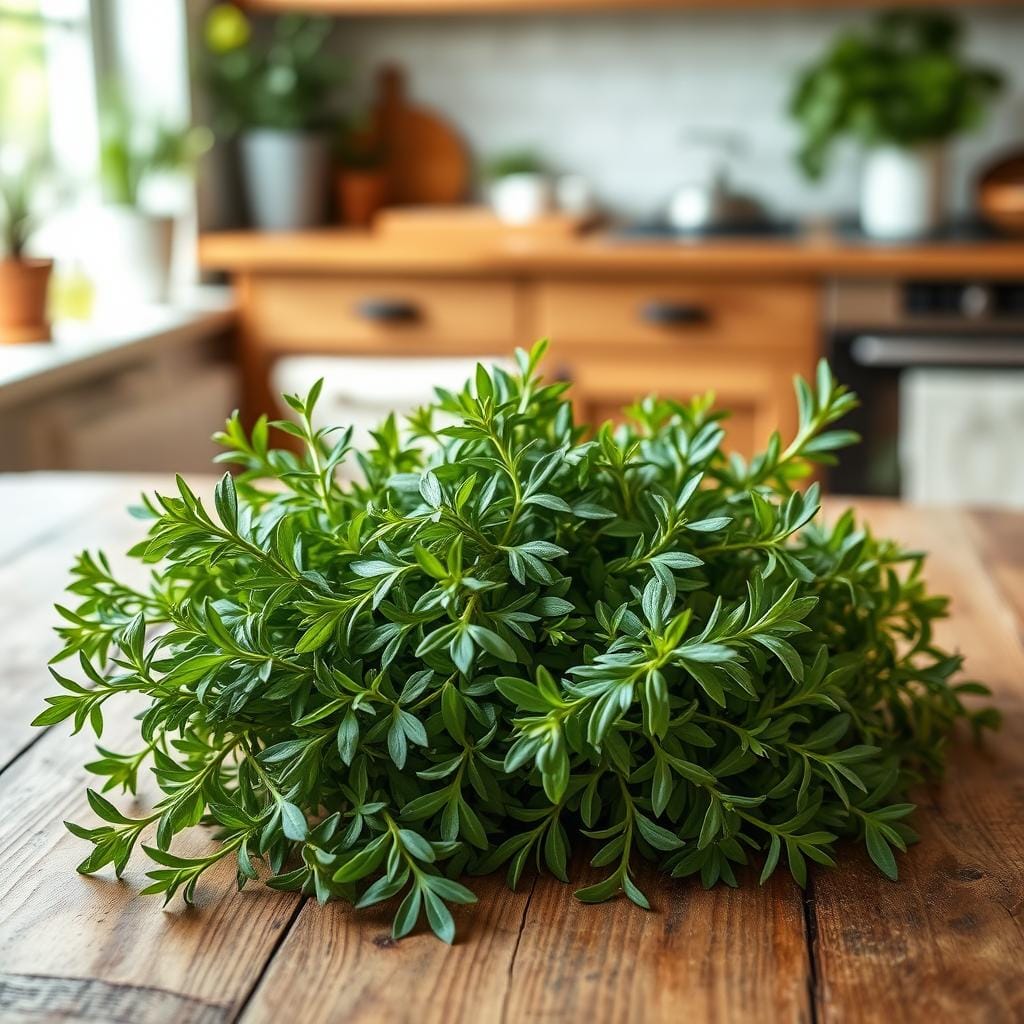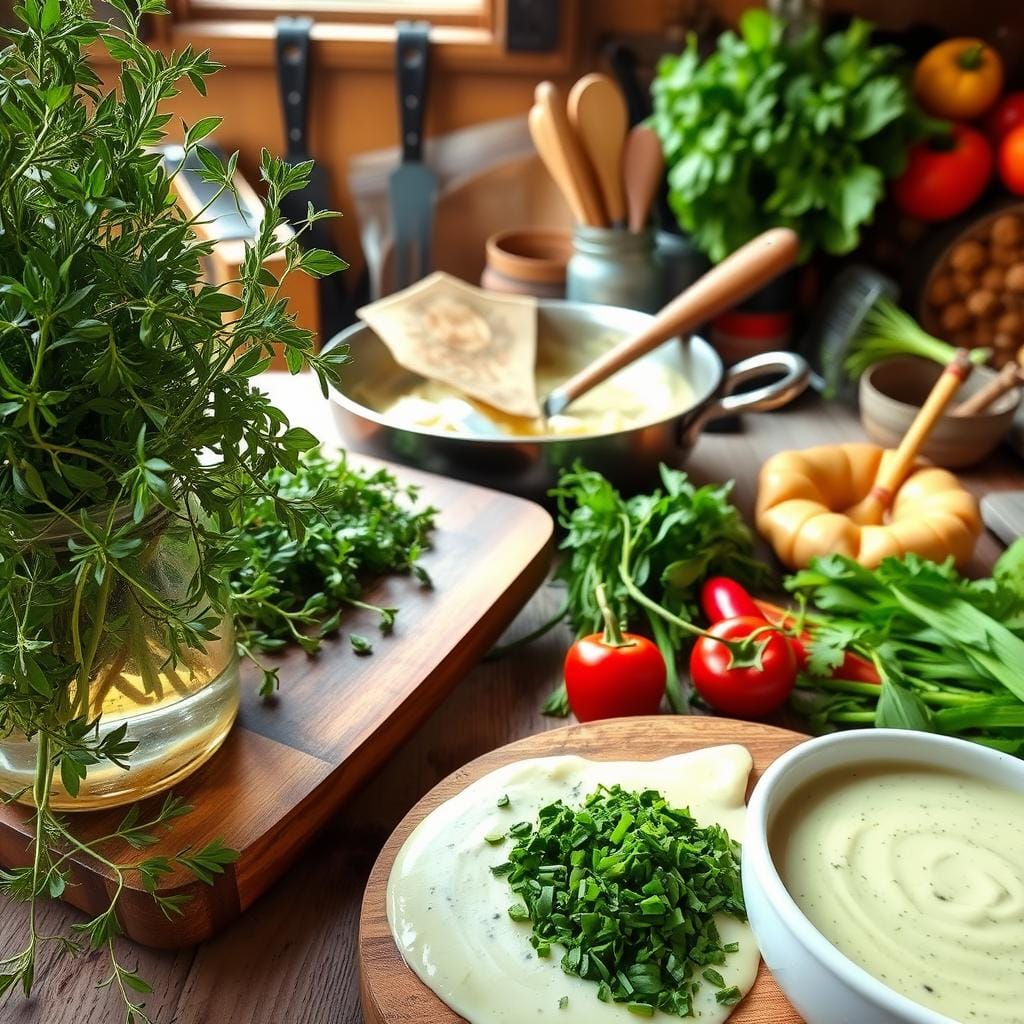The first time I found tarragon, it was like discovering a secret treasure. This herb made my simple chicken dinner taste like a fancy restaurant meal. It woke up my taste buds with its delicate, sophisticated flavor.
Tarragon is more than just another herb. It’s a game-changer in the kitchen. Whether you’re cooking at home or dreaming of being a chef, tarragon can change your dishes. It adds a unique, slightly peppery and sweet taste to your meals.
From French dishes to modern American recipes, tarragon adds a touch of class. It makes your meals unforgettable.
Key Takeaways
- Tarragon adds sophisticated flavor to multiple dishes
- Easy to incorporate into various cooking styles
- Enhances both traditional and modern recipes
- Provides unique aromatic qualities to meals
- Versatile herb with multiple culinary applications
Introduction to Tarragon: The French Dragon Herb
Explore the world of estragon, a treasure in cooking for centuries. Known as artemisia dracunculus, it adds a special flavor to French dishes. This herb will change how you cook.

Tarragon’s history is long and rich. It’s a key ingredient in French cooking, offering more than just taste.
Origins and Varieties of Tarragon
There are two main types of this herb:
- French Tarragon (Most prized in culinary circles)
- Russian Tarragon (Hardier but less flavorful)
Flavor Profile and Aromatic Properties
The flavor of this herb is unique:
- Subtle licorice-like essence
- Delicate peppery undertones
- Mild anise-like aroma
Health Benefits and Nutritional Value
| Nutritional Component | Benefits |
|---|---|
| Vitamin A | Supports eye health |
| Vitamin C | Boosts immune system |
| Antioxidants | Reduces inflammation |
“Tarragon is not just an herb, it’s a culinary passport to French gastronomic excellence.” – Chef Marie Laurent
Whether you’re new to cooking or experienced, learning about tarragon will improve your skills. It brings real French flavors to your kitchen.
Essential Tips for Cooking with Fresh Tarragon
Discovering the magic of tarragon in your cooking is all about its unique scent and flavor. This herb can turn simple meals into something special. It’s all about using it right.

- Select bright green leaves with no wilting or browning
- Store fresh tarragon in a damp paper towel inside a sealed container
- Refrigerate for up to 5 days to maintain optimal flavoring
- Chop leaves just before adding to dishes for maximum aromatic impact
“Fresh tarragon is a culinary treasure that can elevate simple recipes to gourmet status.” – Professional Chef’s Herb Guide
How you cook with tarragon is key. Gentle handling preserves its subtle flavors. Add it towards the end of cooking to keep its taste and smell bright.
| Cooking Method | Tarragon Usage | Best Dishes |
|---|---|---|
| Raw | Finely chopped | Salads, garnishes |
| Sautéing | Added at end | Chicken, fish |
| Infusing | Whole sprigs | Sauces, vinegars |
Learn these tips, and you’ll become a pro at using tarragon. Be bold in your cooking, knowing tarragon can add a touch of elegance to your dishes.
Classic French Dishes Featuring Tarragon
French cuisine loves estragon, making simple dishes special. Tarragon’s unique flavor adds depth to traditional recipes. It makes them taste better and more complex.
Tarragon is key in famous French dishes. It gives a special herbal taste that chefs and home cooks love. Exploring these recipes is a must for anyone who loves French food.
Béarnaise Sauce: A Tarragon-Infused Classic
Béarnaise sauce is a French culinary masterpiece. It’s made with tarragon, egg yolks, butter, and more. It’s perfect with grilled meats and fish, making meals fancy.
- Traditional ingredients include egg yolks, butter, and fresh tarragon
- Requires precise temperature control during preparation
- Best served warm with steak or roasted vegetables
Chicken Tarragon: A Beloved French Recipe
Poulet à l’Estragon turns simple chicken into a fancy dish. Tarragon’s unique flavor makes the meat taste elegant and aromatic.
| Ingredient | Quantity | Purpose |
|---|---|---|
| Chicken | 4 pieces | Main protein |
| Fresh Tarragon | 3 tablespoons | Primary flavoring |
| White Wine | 1/2 cup | Liquid base |
Traditional French Fish Recipes
In French fish dishes, tarragon is a must. Its light, refreshing taste goes well with seafood. It makes the flavors in these dishes wonderful.
“Tarragon is to French cuisine what a painter’s brush is to a canvas – essential and transformative.” – French Master Chef
Tarragon in Modern American Cuisine
Modern American cooking loves tarragon for its unique taste. It turns simple dishes into exciting meals. Chefs use it to make everyday food special.
Restaurants all over the U.S. are adding tarragon to classic dishes. Chefs in California and New York are getting creative with it.
- Tarragon-infused craft cocktails
- Gourmet burger seasonings
- Contemporary fusion appetizers
- Artisan sandwich spreads
Tarragon’s anise-like flavor is great for new takes on old favorites. Culinary innovators use it to enhance grilled meats and vegetarian dishes.
“Tarragon represents the perfect blend of tradition and innovation in American cooking” – Chef Marcus Rodriguez
Regional chefs love tarragon for mixing French techniques with American tastes. It lets them create surprising dishes that please many.
Whether you cook at home or professionally, tarragon can change how you season food. It’s a great way to add depth and excitement to your dishes.
Creative Salad Recipes with Fresh Tarragon
Discover the magic of tarragon, an aromatic herb that adds flavor to summer salads. It can turn simple green dishes into gourmet masterpieces.
Light Summer Combinations
Summer is the perfect time for refreshing salads. Your tarragon-infused salads can be the star of any meal. Try these delightful combinations:
- Watermelon and feta salad with fresh tarragon
- Cucumber and herb salad with lemony tarragon dressing
- Grilled peach salad featuring chopped tarragon
Tarragon Vinaigrette Recipes
Create a vibrant vinaigrette that makes ordinary greens special. Mix fresh tarragon with white wine vinegar, dijon mustard, and olive oil for a classic French dressing.
| Ingredient | Quantity | Purpose |
|---|---|---|
| Fresh Tarragon | 2 tablespoons | Aromatic base |
| White Wine Vinegar | 1/4 cup | Tangy foundation |
| Olive Oil | 1/2 cup | Smooth texture |
Herb-Infused Green Salads
Try mixed green salads that highlight tarragon’s unique flavor. Mix butter lettuce, arugula, and spinach with chopped tarragon for a flavorful delight.
“Tarragon transforms ordinary salads into extraordinary culinary experiences” – Chef Marie Laurent
Once you master these tarragon-infused salad techniques, your summer meals will change. Each recipe offers a fresh way to use this remarkable herb in your kitchen.
Preserving and Storing Your Tarragon
Keeping artemisia dracunculus fresh is key to its flavor. Fresh tarragon is a kitchen gem, but it doesn’t last long. You need the right storage methods to keep it fresh.
Here are some ways to keep your tarragon fresh:
- Refrigeration for short-term storage
- Freezing for extended preservation
- Drying for long-lasting herb use
- Creating herb-infused oils and vinegars
To keep tarragon fresh in the fridge, wrap the stems in damp paper towels. Then, put them in a loose plastic bag. This keeps it fresh for 5-7 days. Freezing is great for longer storage.
| Preservation Method | Duration | Best Uses |
|---|---|---|
| Fresh Refrigeration | 5-7 days | Salads, garnishes |
| Frozen Whole Leaves | 3-6 months | Cooked dishes |
| Dried Tarragon | 6-12 months | Seasoning blends |
To freeze tarragon, chop the leaves and mix with olive oil in ice cube trays. Once frozen, move the cubes to a freezer bag. This keeps the flavor alive for your next dish.
“Properly stored tarragon is a chef’s secret weapon for elevating everyday dishes.” – Culinary Herb Experts
Drying tarragon needs a dark, well-ventilated area. You can hang small bunches upside down or use a food dehydrator. Keep dried herbs in airtight containers, away from light and heat.
Tarragon Butter and Compound Spreads
Discover the magic of tarragon-infused butter and creative spreads. These delights turn simple dishes into culinary wonders. They add a fresh, sophisticated touch to your cooking.
Making Flavored Butters
Making tarragon butter is easy. Begin with soft, unsalted butter. Chop fresh tarragon leaves finely and mix well into the butter. The secret is finding the right balance between the herb’s flavor and the butter’s creaminess.
- Use 1/4 cup finely chopped fresh tarragon per 1/2 pound butter
- Mix herbs evenly throughout the butter
- Add a pinch of sea salt for enhanced flavor
Spread Combinations and Pairings
Try unique tarragon butter mixes to match different dishes. The possibilities are vast when you mix herbs and seasonings.
| Butter Variation | Recommended Pairings |
|---|---|
| Classic Tarragon Butter | Grilled fish, roasted chicken, steamed vegetables |
| Lemon-Tarragon Butter | Seafood, potato dishes, bread |
| Garlic-Tarragon Butter | Steak, roasted vegetables, pasta |
Storage and Usage Tips
Keep your tarragon butter fresh by rolling it in parchment paper and refrigerating. For longer storage, freeze it in small logs. This way, you can use it as needed.
“A good compound butter is like a secret weapon in the kitchen – subtle, versatile, and transformative.” – Professional Chef
Pro tip: Always use fresh tarragon for the best flavor. Your homemade spreads will be a highlight of your cooking.
Substitutes for Tarragon in Recipes
Don’t worry if you’re missing tarragon in your recipe. There are many seasoning alternatives that can save the day. They offer similar flavors to tarragon.
Chefs and home cooks have many options to replace tarragon. It’s important to know each substitute’s unique taste. This way, your dish will still taste like you intended.
- Chervil: The closest match to tarragon, with a delicate anise-like flavor
- Fennel fronds: Provides a similar licorice undertone
- Dried dill: Offers a complementary herbal note
“Cooking is about adaptation and creativity. When one herb is missing, another can beautifully step in.” – Professional Chef Recommendation
To swap herbs successfully, remember to use the same amount as tarragon. This rule helps keep your dish balanced.
| Substitute Herb | Flavor Intensity | Best Used In |
|---|---|---|
| Chervil | Mild | French sauces, egg dishes |
| Fennel Fronds | Medium | Seafood, salads |
| Dried Dill | Strong | Fish recipes, potato dishes |
Start with a small amount of substitute and adjust to taste. Each herb adds its own special touch to your culinary creation. So, don’t be afraid to try new combinations!
Conclusion
Tarragon is a remarkable herb that makes simple dishes extraordinary. It’s a key part of French cuisine, adding depth to any meal. Whether you’re cooking at home or dreaming of becoming a chef, tarragon can take your dishes to the next level.
This herb is not just for French cooking. You can use it in salads, sauces, and even butter. Its unique flavor pairs well with chicken, fish, and veggies. Learning how to use tarragon will boost your cooking skills.
Exploring tarragon is all about creativity and taste. Start with classic recipes and then try your own twists. Every meal is a chance to find new flavors and techniques with tarragon.
Your journey with tarragon is just starting. Dive into its history, be adventurous, and enjoy the tasty dishes it brings to your table.

